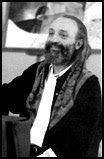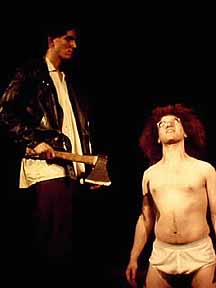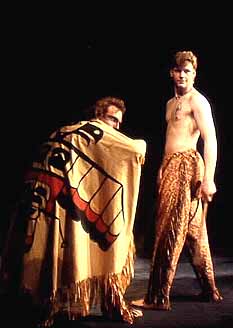|
*
KNIGA Russian Amazon *
FILM-NORTH & VIRTUAL THEATRE
[ advertising space : webmaster ]
BANNERS + POPUPS + LINKS
Moscow Art Theatre School
MOSCOW:
After graduating from the MXAT School in 1956, Oleg Tabakov became a founding member of The Sovremennik (Contemporary) Theatre, serving as its Producing Director between 1971 and 1976. One of the most prominent theatre and movie actors in Russia, Mr. Tabakov has been seen in more than 150 roles at The Sovremennik and at MXAT, including Malvolio in Twelfth Night, Salieri in Amadeus, Ivan Kolomiytsev in The Last People by Maxim Gorky, and Anchugin in Anecdotes by Vampilov. His film appearances most well-known to Western audiences include Oblomov in Oblomov, Scherbuk in Unfinished Piece for the Mechanical Piano, and Pyotr Rostov in War and Peace. He has directed over 30 productions in Austria, Denmark, Finland, Germany, Hungary, Japan, Russia, the United Kingdom, and the United States. Mr. Tabakov joined the MXAT in 1983, was named the head of the MXAT School in 1986, and Artistic Director of the Moscow Art Theatre in 2000. His teaching credentials include workshops and productions at the Paris Conservatoire, the British American Drama Academy, Akademie Der Kunst in Hamburg, the Max Reinhardt Seminar in Vienna, Carnegie Mellon, The Juilliard School, New York University, Florida State University, The University of Delaware, and Harvard University. Mr. Tabakov is the recipient of the highest national and international awards for artistic excellence, including the title of People's Artist of the Soviet Union, the USSR State Prize for the Arts, the Russian State Prize for the Arts, and other national and international awards and decorations from Hungary, France, Poland, and the USSR.
After inviting talented students from the Baumann children theatre studio to study at the Russian State Institute of Theatre Arts, Oleg Tabakov created Theatre-studio in Moscow. The studio settled in one
of the basements in Chapligin street, where it regularly produced performances since 1978. However, the studio budget was constituted only by honorariums of its artistic director. The first attempt to found a studio started in 1980, but it was no earlier than 1987 that authors, critics and admirers were presented a premiere at the УtabakerkaФ,
a theatre reconstructed from the old УBolsheviksТ clubФ.
OLEG TABAKOV: I AM STILL ENJOYING LIFE
By M. Faustova
On August 17 the well-known Russian theatre producer and actor Oleg Tabakov turned 65. Mozart, Talleyrand, Oblomov from the famous novel by the Russian classical writer Ivan Goncharov, Schellenberg from the TV serial "17 Instants Of Spring" about a Soviet secret agent in Berlin during World War II, a cat named Matroskin from a popular cartoon for children... This is just a tiny portion of a huge variety of roles played by Tabakov on stage and in the movies. He was born and grew up in Saratov on the river Volga. Tabakov's extraordinary personality revealed itself in humorous tricks he used to play on his classmates and teachers. His family adored him. "Lelik" - that's how his parents, grandparents and school friends called him - was a chubby mischief-maker intended for a doctor's career.
"In my family all were doctors", says Oleg Tabakov. "And of course, Mother wanted me to continue the family tradition. I often joke that my contribution to domestic medicine is that I haven't become a doctor.
After school "Lelik" left home to conquer Moscow. He was admitted simultaneously to the State Institute of Theatrical Art, or GITIS, and to the Moscow Art Theatre's school-studio. "They must have liked me. They said my eyes were very bright", Tabakov says.
He was a lucky man. When a student, he was offered to play in the movies and in theatre productions. His characters included a lazy and capricious aristocrat, a brave Red Army soldier, a young maximalist and the tyrannical governess from the screen adaptation of "Mary Poppins". For many years Tabakov worked at Moscow's Sovremennik theatre from the moment of its creation, side by side with such prominent actors as Oleg Yefremov, Yevgeny Yevstigneyev, Valentin Gaft and others. In the late 80s he took a rector's post in his "alma mater", the Moscow Art Theatre's school-studio, and later founded his own theatre, dubbed jokingly "Tabakerka" (a tobacco-box). Two and a half months ago he was appointed the artistic director of the Moscow Art Theatre to replace his deceased teacher Oleg Yefremov. "Should anyone have told me 10 years ago that I would be a boss, I wouldn't have believed it. I have never sought to be great, to create my own theatres or to be a rector. The problem is that actors began losing their traditional lead over the theatre. To reverse this trend, I decided to train many good actors capable of regaining the leadership", says Tabakov.
His new status does not prevent him from appearing on stage. There are many roles he still wants to play.
"I haven't played the part of Prince Myshkin from Dostoyevsky's "Idiot', and perhaps never will. I would also like to play Shakespeare's Richard III and King Lear. There are many a character in Alexandr Ostrovsky's dramas that I think I could play and hope I will".
At 65 most people tend to look upon themselves as old and sick. Tabakov is a different sort of man. Always full of energy and ideas, he has a young wife, his former student and now Tabakerka's leading actress Marina Zudina.
"I am still enjoying life. I still hope I can learn something else and surprise my spectators", he says.
Tabakov celebrated his 65-th birthday in Boston, the United States where together with his wife and his son Pavel aged 5 he is spending the summer. Even though on vacation, he continues working. 10 years ago he set up a summer theatre school for American actors. At the beginning of a new theatre season in early September he will appear in the premiere of "Love Letters" at his Tabakerka .
Theatre of St. Petersburg list
Moscow page(s) ...
|
[ from thrlist.html ]
Image of Theatre
YesNo - a place of dramatic actor, object and puppet...
There's an asimmetry of aesthetic techniks.
Lets reveal the antagonism required for the style:
YESNO - Pavel Florenskiy assures "We mustn't cover up
contradictions. Let it be deep as it is." Sergey Averintsev adds:
"A conflict of Yes and No, a change from heat to cold - is the
only thing that preserves existence secure from anthropy, a shape
from chaos."
What follows is a copy of an article found in Volume 1, Number 4 of Theatre Arts Magazine, published in August, 1917. I can only assume that the copyright on this article is now in the public domain. If not, my apologies. If any organization
or individual holds claim to this material, please advise me, and it will be removed, if desired.
Although
I do not necessarily find the opinions of the writer at all times agreeable, I do find it interesting to reflect upon the perceptions of one living in 1917.
The
Moscow Art Theatre: A Model
By N. Ostrovsky
The Moscow
Art Theatre, sometimes known as "The Sea-Gull Theatre", is probably
the most important center of dramatic art in Europe. It is not a theatre in the
American sense. That is, it is not merely a building to which travelling companies
come. Nor is it like your stock companies, which are based on purely commercial
standards, and in which the actors have no more interest than that of making a
living and playing up their personal acting. The Moscow Art Theatre is more like
an art institution, or a craftsmen's cooperative society. It is hardly too much
to say that it is the one art institution in Russia that is best known to the
world.
The history
of the theatre began with a revolt of a forward-seeing playwright, Nemirovitch-Danchenko,
against the stupid conservatism of the established Russian theatres. He was a
dramatic teacher as well as a writer -- the sort of man whom the American theatre
merchants would call a theorist and an outsider. He met in 1897 the since-famous
Konstantin Stanislavsky, who at that time had become known only for his connection
with an amateur dramatic society. The two formed a partnership and determined
to start a new kind of theatre.
The first
company was made up chiefly of amateurs. Rehearsals were started in a barn in
the suburbs of Moscow -- just as humbly as many of your American little theatres
are starting. The first productions, which were given in the unsympathetic atmosphere
of a variety theatre, were treated to a storm of abuse from the critics and the
men of the older theatres. But a few people saw a new something in the company's
work, and the founders persisted in their venture.
In the
early years of the project, the company was hampered by lack of money, and like
many other worthy art ventures, this once contracted a large debt during its first
year. But it found means to continue, and later became an exceedingly profitable
enterprise. At the end of its worst season, a wealthy amateur of Moscow became
interested, and secured the present home of the theatre, building for it one of
the most modern stages in Europe.
The productions
at the theatre are generally divided into three groups. First, there was a realistic
phase, when the founders emulated the famous Theatre Libre of Antoine in
Paris. They were fortunate in discovering the plays of Anton Tchekov. These had
been thrown aside by the regular theatres as impossible, but with them the Art
Theatre made its first great successes. The tendency toward deepest realism and
naturalism continued, with the works of Gorky, Ibsen, Tolstoy and Hauptmann, until
the theatre became stamped as one of the foremost exponents of naturalistic doctrines.
In staging, absolute imitation of natural life became the rule. There was even
an attempt to provide the semblance of the fourth wall of a room at the front
of the stage, and at another time four room were shown on the stage at once. And
in historical productions every detail had to be archaeologically correct. While
this period of the theatre's work is now seen to be very one-sided, it served
a good purpose in demolishing the old trickery and conventionality in acting,
which had been left over from the romantic movement, and it showed up the faults
of the old artificial methods of stage setting.
But a
group of inspired artists could not long be satisfied with mere naturalism. Retaining
their new quiet method of acting, the company swung to the extreme away from realism
in staging. It began to search for utter conventionalization, and adopted a method
of symbolism. The name of Maeterlinck now comes into the theatre's history, and
the symbolistic staging of The Blue Bird was one of the most interesting
achievements of the company. But most important among the experiments in this
direction was the production of Hamlet with no other setting than Gordon
Craig's folding screens. This production has become celebrated throughout Europe
as a classic example of simplified staging.
The third
phase of the theatre's work brought a return to modified realism. While the naturalistic
method of staging was not revived, the purely symbolistic method was set aside
and realistic dramatists came into favor again. The theatre really tried to combine
the two methods, attempting to interpret the realistic plays spiritually. It sought
to attain truth to life -- but artistic and not photographic truth. While preserving
the stylistic, symbolic and lyric notes, which it had learned to value in its
second phase, it tried to get back to types of drama more closely related to the
present world. In Tchekov's plays especially it has learned to create mood.
The acting
company contains no "stars." Perfect ensemble effect is the aim of every
player, and an actor who has an important part in one play may be hardly more
than a "super" in the next. The theatre now has the reputation of being
the home of perhaps the best acting in Europe. Its actors are not taken from regular
theatres, but are preferably trained from youth by the Art Theatre members. A
school, or "Studio," has been established for this purpose, and to make
possible experiments in new methods of staging. There are no curtain-calls, no
matter how successful the production has been. And the audiences are requested
not to applaud at any time during the course of the play.
The managers
of the theatre are very receptive in their attitude toward new ideas, as the invitation
to Gordon Craig to produce Hamlet proves. But, on the other hand, they
never accept a new idea hastily. Indeed, thoroughness is a marked characteristic
of their work. The Hamlet production was in preparation intermittently
for at least three years, and there were 150 rehearsals of The Blue Bird.
The theatre
is organized on the repertory plan. It produces on an average fifteen plays each
year, of which three or four may be new. But on account of the necessity of being
self-supporting, the best productions may be kept on the stage for several weeks.
The theatre seats only about 1,100 people, a happy medium between the little theatres
and huge commercial theatres in this country. Its stage is properly equipped for
art production, with revolving stage and other modern improvements.
The organization
of the company is cooperative. The actors receive comparatively small salaries,
but after five years with the theatre they share generously in its profits, which
now are large. Many of the players could earn a great deal more with other theatres,
but prefer the artistic advantages of a company in which they have a personal
interest.
The administrative
system is a model for art theatres everywhere. A board of directors, composed
of artists and men of affairs specially interested in the theatre, controls the
general policy. The purely artistic activities are placed in the hands of the
famous director Stanislavsky, to whom the actors and other workers on the stage
must be obedient, and there is a business secretary who has charge of administrative
matters aside from the producing of plays. The audiences also feel a cooperative
interest in the theatre, since nearly all the seats are sold under a yearly subscription
plan. Incidentally, they cost less than seats at the American theatres.
Altogether,
it is probable that your little theatres can learn more from the Moscow Art Theatre
than from any other in the world.
http://www.actors-studio.com/history/mat.html





